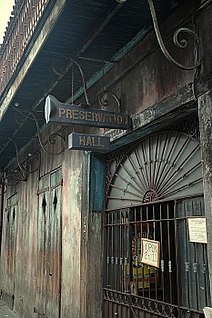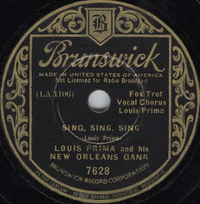Related Research Articles

A musical ensemble, also known as a music group or musical group, is a group of people who perform instrumental or vocal music, with the ensemble typically known by a distinct name. Some music ensembles consist solely of instrumentalists, such as the jazz quartet or the orchestra. Other music ensembles consist solely of singers, such as choirs and doo wop groups. In both popular music and classical music, there are ensembles in which both instrumentalists and singers perform, such as the rock band or the Baroque chamber group for basso continuo and one or more singers. In classical music, trios or quartets either blend the sounds of musical instrument families or group together instruments from the same instrument family, such as string ensembles or wind ensembles. Some ensembles blend the sounds of a variety of instrument families, such as the orchestra, which uses a string section, brass instruments, woodwinds and percussion instruments, or the concert band, which uses brass, woodwinds and percussion.

Thomas Wright "Fats" Waller was an American jazz pianist, organist, composer, violinist, singer, and comedic entertainer. His innovations in the Harlem stride style laid the groundwork for modern jazz piano. His best-known compositions, "Ain't Misbehavin'" and "Honeysuckle Rose", were inducted into the Grammy Hall of Fame in 1984 and 1999. Waller copyrighted over 400 songs, many of them co-written with his closest collaborator, Andy Razaf. Razaf described his partner as "the soul of melody... a man who made the piano sing... both big in body and in mind... known for his generosity... a bubbling bundle of joy". It is likely that he composed many more popular songs than he has been credited: when in financial difficulties he had a habit of selling songs to other writers and performers who claimed them as their own.

Rhapsody in Blue is a 1924 musical composition written by George Gershwin for solo piano and jazz band, which combines elements of classical music with jazz-influenced effects. Commissioned by bandleader Paul Whiteman, the work premiered in a concert titled "An Experiment in Modern Music" on February 12, 1924, in Aeolian Hall, New York City. Whiteman's band performed the rhapsody with Gershwin playing the piano. Whiteman's arranger Ferde Grofé orchestrated the rhapsody several times including the 1924 original scoring, the 1926 pit orchestra scoring, and the 1942 symphonic scoring.

George Lewis was an American jazz clarinetist who achieved his highest profile in the later decades of his life.

Preservation Hall is a jazz venue in the French Quarter of New Orleans, Louisiana. The building is associated with a house band, a record label, and a non-profit foundation.

Preservation Hall Jazz Band is a New Orleans jazz band founded in New Orleans by tuba player Allan Jaffe in the early 1960s. The band derives its name from Preservation Hall in the French Quarter. In 2005, the Hall's doors were closed for a period of time due to Hurricane Katrina, but the band continued to tour.

"Sing, Sing, Sing " is a 1936 song, with music and lyrics by Louis Prima, who first recorded it with the New Orleans Gang. Brunswick Records released it on February 28, 1936 on the 78 rpm record format, with "It's Been So Long" as the B-side. The song is strongly identified with the big band and swing eras. Several have performed the piece as an instrumental, including Fletcher Henderson and, most famously, Benny Goodman.
Graeme Emerson Bell, AO, MBE was an Australian Dixieland and classical jazz pianist, composer and band leader. According to The Age, his "band's music was hailed for its distinctive Australian edge, which he describes as 'nice larrikinism' and 'a happy Aussie outdoor feel'".
James Lamont Gillespie pen name Haven Gillespie, was an American Tin Pan Alley composer and lyricist. He was the writer of "You Go to My Head", "Honey", "By the Sycamore Tree", "That Lucky Old Sun", "Breezin' Along With The Breeze", "Right or Wrong," "Beautiful Love", "Drifting and Dreaming", and "Louisiana Fairy Tale", each song in collaboration with other people such as Beasley Smith, Ervin R. Schmidt, Richard A. Whiting, Wayne King, and Loyal Curtis. He also wrote the seasonal standard "Santa Claus Is Comin' to Town".
Black and Tan (1929) is a musical short film written and directed by Dudley Murphy. The plot is about a couple in the performing arts; it is set during the contemporary Harlem Renaissance in New York City. It is the first film to feature Duke Ellington and His Orchestra performing as a jazz band, and was also the film debut of actress Fredi Washington. The film is thought to express the emergence of African-American artists in New York City during the Harlem Renaissance.
"Ain't Misbehavin'" is a 1929 stride jazz/early swing song. Andy Razaf wrote the lyrics to a score by Thomas "Fats" Waller and Harry Brooks for the Broadway musical comedy play Connie's Hot Chocolates.

Wilhelmina Madison Goodson, known professionally as Billie Pierce was an American jazz pianist and singer, who performed and recorded with her husband De De Pierce. Her style has been described as a "potent mixture of barrelhouse, boogie-woogie, and ragtime". After settling in New Orleans in 1930, she played in the bands of A.J. Piron, Alphonse Picou, Emile Barnes, and George Lewis.

Thomas Alexander Sancton is an American writer, jazz clarinetist and educator. From 1992 to 2001 he was Paris bureau chief for TIME Magazine, where he worked for 22 years, and he has contributed to publications including Vanity Fair, Fortune, Newsweek and the Wall Street Journal. His acclaimed memoir, Song for My Fathers: a New Orleans Story in Black and White (2006), recounts his early life among traditional jazzmen in his native New Orleans. He taught journalism at the American University of Paris from 2002 to 2004. In 2007 he was named Andrew W. Mellon Professor in the Humanities at Tulane University, where he taught creative writing until 2011. He is currently a Research Professor at Tulane.

"Whispering" is a popular song. "Whispering" was first published in 1920 by Sherman, Clay & Co., of San Francisco. The initial 1920 copyright and first publishing attributes the lyrics to Malvin Schonberger and the music to John Schonberger.
"There'll Be Some Changes Made" ("Changes") is a popular song by Benton Overstreet (composer) and Billy Higgins (lyricist). Published in 1921, the song has flourished in several genres, particularly jazz. The song has endured for as many years as a jazz standard. According to the online The Jazz Discography, "Changes" had been recorded 404 times as of May 2018. The song and its record debut were revolutionary, in that the songwriters (Overstreet and Higgins, the original copyright publisher, Harry Herbert Pace, the vocalist to first record it, the owners of Black Swan, the opera singer for whom the label was named, and the musicians on the recording led by Fletcher Henderson, were all African American. The production is identified by historians as a notable part of the Harlem Renaissance.
The Louis Armstrong Hot Five and Hot Seven Sessions were recorded between 1925 and 1928 by Louis Armstrong with his Hot Five and Hot Seven groups. According to the National Recording Registry, "Louis Armstrong was jazz's first great soloist and is among American music's most important and influential figures. These sessions, his solos in particular, set a standard musicians still strive to equal in their beauty and innovation." These recordings were added to the National Recording Registry in 2002, the first year of the institution's existence.

Ostrich Walk" is a 1917 jazz composition by the Original Dixieland Jass Band released as an instrumental as an Aeolian Vocalion and a Victor 78. Frankie Trumbauer and Bix Beiderbecke recorded the song in 1927. The song is a jazz milestone as one of the first commercially released "jass" or jazz recordings.

Dave Albert Williams Jr. was an American jazz, blues, and rhythm & blues pianist, bandleader, singer, and songwriter. He was the author of "I Ate Up The Apple Tree", a staple of contemporary New Orleans brass bands. His career as a working musician spanned five decades.
References
- ↑ Stephen Taylor (2006). Fats Waller on the air: the radio broadcasts and discography. Scarecrow Press Inc. p. 200. ISBN 9780810856561.
- ↑ "Stories of Standards: "You Go to My Head"". KUVO . Retrieved July 22, 2020.
- ↑ Dan Morgenstern (2004). Living with Jazz: A reader edited by Sheldon Meyer. Random House Digital. ISBN 9780307487605.
- ↑ "This Old House - FAQs". Archived from the original on 2011-11-29. Retrieved July 22, 2020.
- ↑ Thomas E. Ahr (1992). "Show and Tell". Cincinnati Magazine: 27.
- ↑ "A "Dear Wife" Comes to Library Reception", Library of Congress Information Bulletin (1990), p. 336.
- ↑ "My Morning Jacket at Preservation Hall - Louisiana Fairytale".
- ↑ Tad Hendrickson (May 7, 2012). "Louisiana Fairytale by Jim James and the Preservation Hall Jazz Band | Song Stories". Rolling Stone . Retrieved 2013-07-18.
- ↑ "Louisiana Fairytale - Tommy Sancton | Songs, Reviews, Credits, Awards". AllMusic. 1999-12-25. Retrieved 2013-07-18.